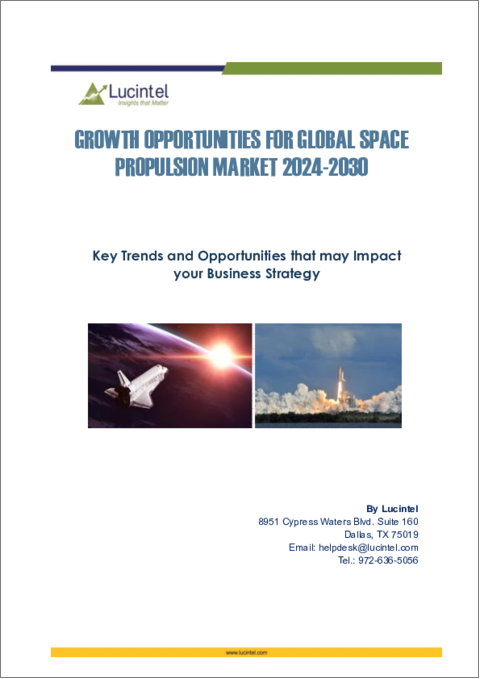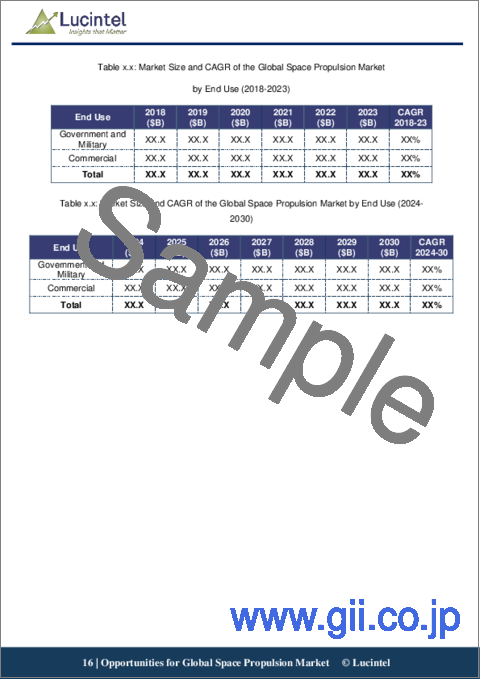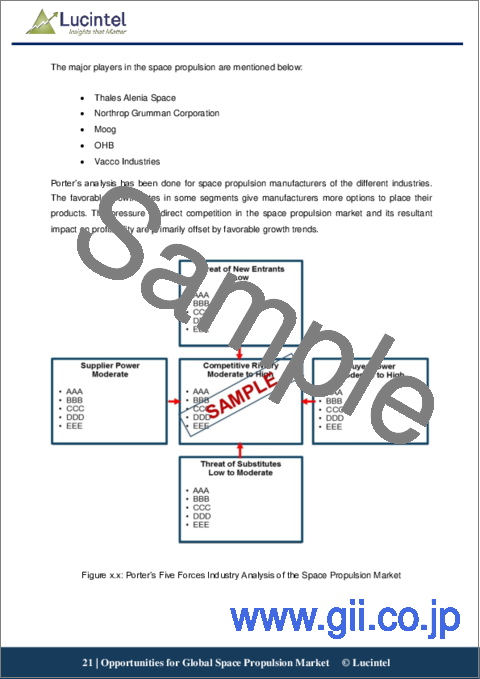|
|
市場調査レポート
商品コード
1356750
宇宙推進市場レポート:2030年までの動向、予測、競合分析Space Propulsion Market Report: Trends, Forecast and Competitive Analysis to 2030 |
||||||
|
● お客様のご希望に応じて、既存データの加工や未掲載情報(例:国別セグメント)の追加などの対応が可能です。 詳細はお問い合わせください。 |
|||||||
| 宇宙推進市場レポート:2030年までの動向、予測、競合分析 |
|
出版日: 2023年09月01日
発行: Lucintel
ページ情報: 英文 150 Pages
納期: 3営業日
|
- 全表示
- 概要
- 目次
宇宙推進の動向と予測
世界の宇宙推進市場は、2024年から2030年までのCAGRが11.0%で、2030年までに推定212億米ドルに達すると予想されています。この市場の主な促進要因は、宇宙探査ミッション数の増加、衛星データ需要の増大、電気推進システムのような次世代推進システムのイントロダクションです。世界の宇宙推進市場の将来は、政府・軍事・商業市場における機会によって有望視されています。
宇宙推進市場の洞察
Lucintelは、探査機/宇宙船着陸機が予測期間中に最も高い成長を遂げると予測しています。
この市場の中では、政府・軍需が最大のセグメントであり続けると思われます。
アジア太平洋地域は予測期間中に最も高い成長が見込まれます。
本レポートでは、以下の11の主要な質問に回答しています:
- Q.1.市場セグメントのうち、最も有望かつ高成長な機会は何か?
- Q.2.どのセグメントがより速いペースで成長するのか、またその理由は?
- Q.3.今後成長が加速すると思われる地域とその理由は?
- Q.4.市場力学に影響を与える主な要因は何か?市場における主な課題とビジネスリスクは?
- Q.5.この市場におけるビジネスリスクと競合の脅威は?
- Q.6.この市場における新たな動向とその理由は?
- Q.7.市場における顧客の需要の変化にはどのようなものがありますか?
- Q.8.この市場における新たな開発と、その開発をリードしている企業は?
- Q.9.この市場における主要企業は?主要企業は事業成長のためにどのような戦略的取り組みを進めているのか?
- Q.10.この市場における競合製品にはどのようなものがあり、材料や製品の代替による市場シェア低下の脅威はどの程度ありますか?
- Q.11.過去5年間にどのようなM&Aが行われ、業界にどのような影響を与えましたか?
目次
第1章 エグゼクティブサマリー
第2章 世界の宇宙推進市場:市場力学
- イントロダクション、背景、分類
- サプライチェーン
- 業界の促進要因と課題
第3章 2018年から2030年までの市場動向と予測分析
- マクロ経済動向(2018~2023年)と予測(2024~2030年)
- 世界の宇宙推進市場の動向(2018-2023)と予測(2024-2030)
- プラットフォーム別の世界の宇宙推進市場
- 衛星
- カプセル/カーゴ
- 惑星間宇宙船と探査機
- 探査車/宇宙船着陸船
- ロケット
- システムコンポーネント別の世界の宇宙推進市場
- スラスター
- 推進剤供給システム
- ノズル
- ロケットモーター
- 推進力の熱制御
- 電力処理装置
- その他
- 軌道別の世界の宇宙推進市場
- 地球低軌道(LEO)
- 中地球軌道(MEO)
- 静止地球軌道(GEO)
- 静止軌道を超えて
- 最終用途産業別の世界の宇宙推進市場
- 政府と軍
- コマーシャル
第4章 2018年から2030年までの地域別の市場動向と予測分析
- 地域別の世界の宇宙推進市場
- 北米の宇宙推進市場
- 欧州宇宙推進市場
- アジア太平洋宇宙推進市場
- その他地域宇宙推進市場
第5章 競合の分析
- 製品ポートフォリオ分析
- 運用上の統合
- ポーターのファイブフォース分析
第6章 成長機会と戦略的分析
- 成長機会分析
- プラットフォーム別の世界の宇宙推進市場の成長機会
- システムコンポーネント別の世界の宇宙推進市場の成長機会
- 軌道による世界の宇宙推進市場の成長機会
- 最終用途産業別の世界の宇宙推進市場の成長機会
- 地域別の世界の宇宙推進市場の成長機会
- 世界の宇宙推進市場の新たな動向
- 戦略的分析
- 新製品の開発
- 世界の宇宙推進市場の能力拡大
- 世界の宇宙推進市場における合併、買収、合弁事業
- 認証とライセンシング
第7章 有力企業の企業プロファイル
- Thales Northrop Grumman Corporation
- Moog
- OHB
- Vacco Industries
- Space Exploration Technologies
- IHI Corporation
- Ariane
- Safran Corporation
- Accion Systems
Space Propulsion Trends and Forecast
The future of the global space propulsion market looks promising with opportunities in the government and military and commercial markets. The global space propulsion market is expected to reach an estimated $21.2 billion by 2030 with a CAGR of 11.0% from 2024 to 2030. The major drivers for this market are increase in number of space exploration missions, growing demand for satellite data, and introduction of the next-generation propulsion systems like electric propulsion system.
A more than 150-page report is developed to help in your business decisions.
Space Propulsion by Segment
The study includes a forecast for the global space propulsion by platform, system component, orbit, end use industry, and region.
Space Propulsion Market by Platform [Shipment Analysis by Value from 2018 to 2030]:
- Satellites
- Capsules/Cargo
- Interplanetary Spacecraft & Probes
- Rovers/ Spacecraft Landers
- Launch Vehicles
Space Propulsion Market by System Component [Shipment Analysis by Value from 2018 to 2030]:
- Thrusters
- Propellant Feed System
- Nozzle
- Rocket Motors
- Propulsion Thermal Control
- Power Processing Units
- Others
Space Propulsion Market by Orbit [Shipment Analysis by Value from 2018 to 2030]:
- Low Earth Orbit (LEO)
- Medium Earth Orbit (MEO)
- Geostationary Earth Orbit (GEO)
- Beyond Geosynchronous Orbit
Space Propulsion Market by End Use Industry [Shipment Analysis by Value from 2018 to 2030]:
- Government and Military
- Commercial
Space Propulsion Market by Region [Shipment Analysis by Value from 2018 to 2030]:
- North America
- Europe
- Asia Pacific
- The Rest of the World
List of Space Propulsion Companies
Companies in the market compete on the basis of product quality offered. Major players in this market focus on expanding their manufacturing facilities, R&D investments, infrastructural development, and leverage integration opportunities across the value chain. With these strategies space propulsion companies cater increasing demand, ensure competitive effectiveness, develop innovative products & technologies, reduce production costs, and expand their customer base. Some of the space propulsion companies profiled in this report include-
- Thales Alenia Space
- Northrop Grumman Corporation
- Moog
- OHB SE
- Vacco Industries
- Space Exploration Technologies
- IHI Corporation
- Ariane
- Safran Corporation
- Accion Systems
Space Propulsion Market Insights
Lucintel forecasts that rovers/ spacecraft landers is expected to witness highest growth over the forecast period.
Within this market, government and military will remain the largest segment.
Asia Pacific is expected to witness highest growth over the forecast period.
Features of the Global Space Propulsion Market
Market Size Estimates: Space propulsion market size estimation in terms of value ($B).
Trend and Forecast Analysis: Market trends (2018 to 2023) and forecast (2024 to 2030) by various segments and regions.
Segmentation Analysis: Space propulsion market by various segments, such as by platform , system component , orbit, end use industry, and region. in terms of($B).
Regional Analysis: Space propulsion market breakdown by North America, Europe, Asia Pacific, and Rest of the World.
Growth Opportunities: Analysis of growth opportunities in different platforms, system components, orbits, end use industries, and region.s for the space propulsion market.
Strategic Analysis: This includes M&A, new product development, and competitive landscape of the space propulsion market.
Analysis of competitive intensity of the industry based on Porter's Five Forces model.
FAQ
Q.1. What is the space propulsion market size?
Answer: The global space propulsion market is expected to reach an estimated $21.2 billion by 2030.
Q.2. What is the growth forecast for space propulsion market?
Answer: The global space propulsion market is expected to grow with a CAGR of 11.0% from 2024 to 2030.
Q.3. What are the major drivers influencing the growth of the space propulsion market?
Answer: The major drivers for this market are increase in number of space exploration missions, growing demand for satellite data, and introduction of the next-generation propulsion systems like electric propulsion system.
Q.4. What are the major segments for space propulsion market?
Answer: The future of the space propulsion market looks promising with opportunities in the government and military and commercial markets.
Q.5. Who are the key space propulsion market companies?
Answer: Some of the key space propulsion companies are as follows:
- Thales Alenia Space
- Northrop Grumman Corporation
- Moog
- OHB SE
- Vacco Industries
- Space Exploration Technologies
- IHI Corporation
- Ariane
- Safran Corporation
- Accion Systems
Q.6. Which space propulsion market segment will be the largest in future?
Answer: Lucintel forecasts that rovers/ spacecraft landers is expected to witness highest growth over the forecast period.
Q.7. In space propulsion market, which region is expected to be the largest in next 5 years?
Answer: North America is expected to witness highest growth over the forecast period.
Q.8. Do we receive customization in this report?
Answer: Yes, Lucintel provides 10% customization without any additional cost.
This report answers following 11 key questions:
- Q.1. What are some of the most promising, high-growth opportunities for the space propulsion market by platform (satellites, capsules/cargo, interplanetary spacecraft & probes,rovers/ spacecraft landers, and launch vehicles), system component (thrusters, propellant feed system, nozzle, rocket motors, propulsion thermal control, power processing units, and others), orbit (low earth orbit (LEO), medium earth orbit (MEO), geostationary earth orbit (GEO), and beyond geosynchronous orbit), end use industry (government and military, and commercial), and region. (North America, Europe, Asia Pacific, and the Rest of the World)?
- Q.2. Which segments will grow at a faster pace and why?
- Q.3. Which region will grow at a faster pace and why?
- Q.4. What are the key factors affecting market dynamics? What are the key challenges and business risks in this market?
- Q.5. What are the business risks and competitive threats in this market?
- Q.6. What are the emerging trends in this market and the reasons behind them?
- Q.7. What are some of the changing demands of customers in the market?
- Q.8. What are the new developments in the market? Which companies are leading these developments?
- Q.9. Who are the major players in this market? What strategic initiatives are key players pursuing for business growth?
- Q.10. What are some of the competing products in this market and how big of a threat do they pose for loss of market share by material or product substitution?
- Q.11. What M&A activity has occurred in the last 5 years and what has its impact been on the industry?
Table of Contents
1. Executive Summary
2. Global Space Propulsion Market : Market Dynamics
- 2.1: Introduction, Background, and Classifications
- 2.2: Supply Chain
- 2.3: Industry Drivers and Challenges
3. Market Trends and Forecast Analysis from 2018 to 2030
- 3.1. Macroeconomic Trends (2018-2023) and Forecast (2024-2030)
- 3.2. Global Space Propulsion Market Trends (2018-2023) and Forecast (2024-2030)
- 3.3: Global Space Propulsion Market by Platform
- 3.3.1: Satellites
- 3.3.2: Capsules/Cargo
- 3.3.3: Interplanetary Spacecraft & Probes
- 3.3.4: Rovers/ Spacecraft Landers
- 3.3.5: Launch Vehicles
- 3.4: Global Space Propulsion Market by System Component
- 3.4.1: Thrusters
- 3.4.2: Propellant Feed System
- 3.4.3: Nozzle
- 3.4.4: Rocket Motors
- 3.4.5: Propulsion Thermal Control
- 3.4.6: Power Processing Units
- 3.4.7: Others
- 3.5: Global Space Propulsion Market by Orbit
- 3.5.1: Low Earth Orbit (LEO)
- 3.5.2: Medium Earth Orbit (MEO)
- 3.5.3: Geostationary Earth Orbit (GEO)
- 3.5.4: Beyond Geosynchronous Orbit
- 3.6: Global Space Propulsion Market by End Use Industry
- 3.6.1: Government and Military
- 3.6.2: Commercial
4. Market Trends and Forecast Analysis by Region from 2018 to 2030
- 4.1: Global Space Propulsion Market by Region
- 4.2: North American Space Propulsion Market
- 4.2.2: North American Space Propulsion Market by End Use Industry: Government and Military and Commercial
- 4.3: European Space Propulsion Market
- 4.3.1: European Space Propulsion Market by Platform: Satellites, Capsules/Cargo, Interplanetary Spacecraft & Probes,Rovers/ Spacecraft Landers, and Launch Vehicles
- 4.3.2: European Space Propulsion Market by End Use Industry: Government and Military and Commercial
- 4.4: APAC Space Propulsion Market
- 4.4.1: APAC Space Propulsion Market by Platform: Satellites, Capsules/Cargo, Interplanetary Spacecraft & Probes,Rovers/ Spacecraft Landers, and Launch Vehicles
- 4.4.2: APAC Space Propulsion Market by End Use Industry: Government and Military and Commercial
- 4.5: ROW Space Propulsion Market
- 4.5.1: ROW Space Propulsion Market by Platform: Satellites, Capsules/Cargo, Interplanetary Spacecraft & Probes,Rovers/ Spacecraft Landers, and Launch Vehicles
- 4.5.2: ROW Space Propulsion Market by End Use Industry: Government and Military and Commercial
5. Competitor Analysis
- 5.1: Product Portfolio Analysis
- 5.2: Operational Integration
- 5.3: Porter's Five Forces Analysis
6. Growth Opportunities and Strategic Analysis
- 6.1: Growth Opportunity Analysis
- 6.1.1: Growth Opportunities for the Global Space Propulsion Market by Platform
- 6.1.2: Growth Opportunities for the Global Space Propulsion Market by System Component
- 6.1.3: Growth Opportunities for the Global Space Propulsion Market by Orbit
- 6.1.4: Growth Opportunities for the Global Space Propulsion Market by End Use Industry
- 6.1.5: Growth Opportunities for the Global Space Propulsion Market by Region
- 6.2: Emerging Trends in the Global Space Propulsion Market
- 6.3: Strategic Analysis
- 6.3.1: New Product Development
- 6.3.2: Capacity Expansion of the Global Space Propulsion Market
- 6.3.3: Mergers, Acquisitions, and Joint Ventures in the Global Space Propulsion Market
- 6.3.4: Certification and Licensing
7. Company Profiles of Leading Players
- 7.1: Thales Northrop Grumman Corporation
- 7.3: Moog
- 7.4: OHB
- 7.5: Vacco Industries
- 7.6: Space Exploration Technologies
- 7.7: IHI Corporation
- 7.8: Ariane
- 7.9: Safran Corporation
- 7.10: Accion Systems




